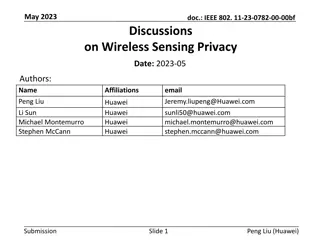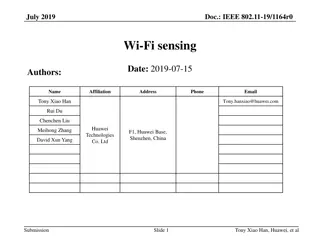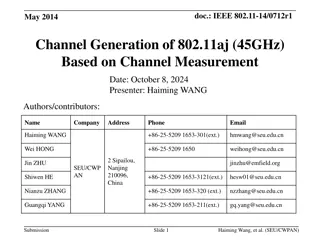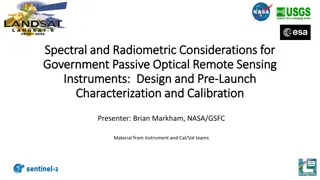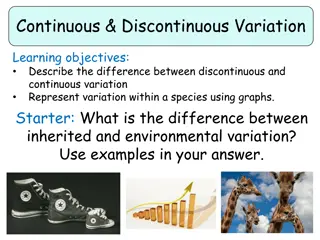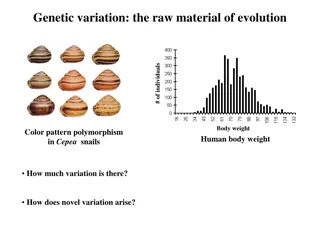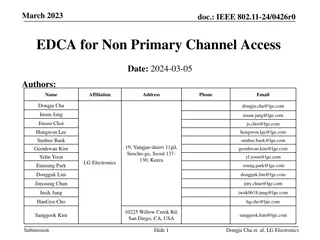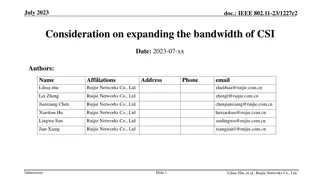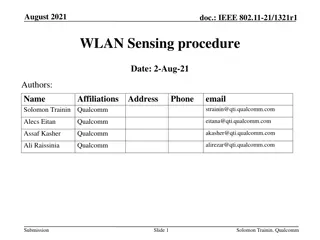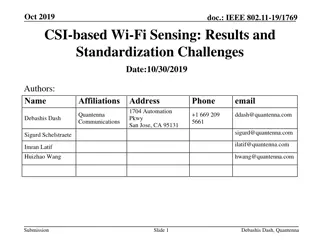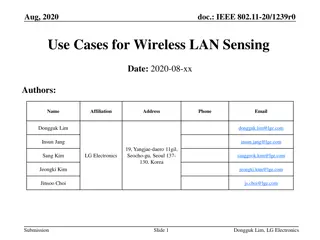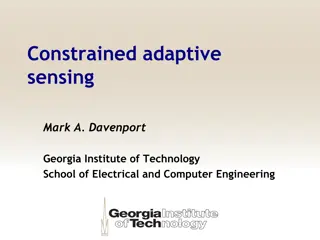MUSE-Fi: Exploiting Near-field Wi-Fi Channel Variation for Multi-person Sensing
"MUSE-Fi is a groundbreaking system that leverages Wi-Fi channel state information (CSI) variations caused by human movements to enable contactless multi-person sensing. By analyzing CSI obtained from Wi-Fi data frames, this technology offers insights into vital signs monitoring, gesture detection, activity recognition, and more. Challenges include theoretical analysis, experimental verification, and sparse CSI samples, all addressed through the innovative MUSE-Fi system."
Download Presentation

Please find below an Image/Link to download the presentation.
The content on the website is provided AS IS for your information and personal use only. It may not be sold, licensed, or shared on other websites without obtaining consent from the author. Download presentation by click this link. If you encounter any issues during the download, it is possible that the publisher has removed the file from their server.
E N D
Presentation Transcript
MUSE-Fi: Contactless MUti-person SEnsing Exploiting Near-field Wi-Fi Channel Variation Jingzhi Hu*, Tianyue Zheng*, Zhe Chen, Hongbo Wang, Jun Luo Nanyang T echnological University (Singapore) and Fudan University (China) Presented by Yinghui He, Zhejiang University (China)
01 Background on Wi-Fi Sensing 02 Principle of Near-field Sensing 03 Insights into Multi-person Sensing 04 Shaping up MUSE-Fi 05 Experimental Results
Wi-Fi human sensing basics Channel state information (CSI) obtained from the long training sequence (LTS) in data frames Sensing with variations of CSI caused by human movements Background on Wi-Fi Sensing Basics Various important applications Vital signs monitoring, gesture detection, activity recognition Localization and motion tracking Multi-person sensing faces challenges Inadequate bandwidth and antennas insufficient spatial resolution 20~160MHz bandwidth
Existing solutions GHz-level bandwidth to improve range resolution Many (distributed) antennas for higher spatial resolution Signal processing techniques for post-processing Drawbacks: extra spectrum resources; hard for ubiquitous deployment; complex controlling protocols; unguaranteed & insufficient separability Background on Wi-Fi Sensing Our way: exploiting natural communications setting Scene: User equipment (UE) in the near-field ( 0.2?) of a user Idea: CSI variations of each UE-AP link caused by its near-field user dominate interference from others Meaning: Naturally extend Wi-Fi comm. to support multi-person sensing Potential Applications: VR/AR/MR/XR Reduce peripheral sensors of headsets Provide contextual and localizational information near Wi-Fi devices Now and Then
Challenges Idea of near-field sensing lacks of theoretical analysis, experimental verification, and protocol integration Realistic data traffic in Wi-Fi, especially in multi-UE scenarios, is of unsaturated, even low frequency, causing sparsity in CSI samples. Background on Wi-Fi Sensing Challenge and Solution Frame arrival rates when one or two users stream 1080p videos Solution:MUSE-Fi (MUlti-person SEnsing system leveraging Wi-Fi) Theoretical characterization, prototyping, and experiment evaluations Various WiFi-compatible sensing strategies Recovery algorithm to tackle sparsity in CSI sampling rate
More on Wi-Fi sensing basics Channel between AP and UE = Reflection channel via subject S + static channel + env. dynamic channel Principle Path loss exponent Distance S to UE Distance AP to S of Near-field Sensing (NFS) Near-field domination effect (NFDE) 2 ?, ? ?,?,?? ?? 2??,???,? Power of CSI variation ?? ?? As CSI variations mater, ??: intensity/speed of movement As ??,? of near-field subject is much smaller than ??,? of interferers, variation power ?? of subject dominates ?? of interferer (near-field domination) ?th=50 Derivation of feasible regions for NFS Metric: variation to interference ratio (VIR) Envir. dynamic channel gain as an interference Illustration and observation: VIR?> ?th constitutes Cassini ovals, physically guarantee boundaries for user separation Subject and interferer can be very close (0.3-0.5m)
Ideal multi-person (? > 3) scenes Symmetry cases and normalized parameters (a) Radial symmetry case for maximum ? Insights ?max= 51 ?min= 0.34 of Multi-person Sensing (MPS) ?max peaks at 51 around AP-UE distance ? 3m ?th=50 (b) Mirror symmetry case for minimum ? ?min remains 0.34m for ? 0.32,3.30 m Proof of concept experiments Respirations of closely-sit persons (even by-shoulder) can be well separated NFS works for different motion intensities: stronger signals do not mess up weaker ones
Hardware Components A commodity AP and multiple UEs carried by individual users: All devices follow prevalent Wi-Fi 5/6 standard CSI can be obtained from the received frames No additional antennas or bandwidth expansion Shaping up MUSE-Fi Strategies compatible with WiFi-ISAC (integrated sensing & communication) Components, Strategies, Compatibility Uplink (UL)-CSI: AP obtains CSI from UEs' UL traffic Centralized sensing at AP, covering all users Downlink (DL)-CSI: UEs obtain CSI from AP's DL traffic Distributed sensing at UE, privacy preserving UL-BFI: Beamforming feedback info (BFI) in UEs' UL traffic As BFI is sent out in plain-text, sensing can be carried out at any Wi-Fi devices capable of hearing the traffic (WiKI-Eve in CCS 23)
Goal: handle CSI sample sparsity in realistic data traffic Data processing pipeline Divide sparse and non-sparse time slices Linearly resample/temporarily fill Transform resampled CSI time series into spectrogram featuring freq. components Normalize spectrogram and re-assign `no-data` labels to sparse slices Shaping up MUSE-Fi Sparse Recovery Algorithm (SRA) Sparse slice recovery with TCN-AE Adopts temporal conv. network (TCN) due to its parameter efficiency TCN is featured by dilated conv. output kernel input ? > 1: dilation factor Self-supervised training Use non-sparse slices as labeled training data for sparse slices
Implementation AP: commercial Netgear router UE: iPhone 13, iPhone X, OnePlus 10T, Acer TravelMate laptops Retrieval of CSI: with the help of PicoScenes or Nexmon hardware Retrieval of BFI: from Action No ACK frames captured by Wireshark software Data traffic: e.g., video streaming Evaluating SRA Low MSE losses of the recovery in case of resp., gesture, and activity sensing (<10-2) Respiration Monitoring MUSE-Fi recovers a clear respiration signal NFS halves the average spectral entropy Experiment Results Implementation and Evaluations Baseline: non-near-field sensing setup for multi-person sensing
Gesture detection Gestures: circle (CR), front-back (FB), slide (SL), star (ST), wave (WV), and zig-zag (ZZ) Result: MUSE-Fi achieves about 98% accuracy for arbitrary subject thanks to near-field domination, while non-near-field baseline 57% Activity recognition Actions: bending (BD), jumping (JM), rotating (RT), sitting down (SD), standing up (SU), and walking (WL). Result: MUSE-Fi 98% vs. non-near-field baseline 52% Experiment Results Evaluation Continued Extended experiments UE is kept in subject's pocket: NLoSwith AP Similar accuracy is achieved






